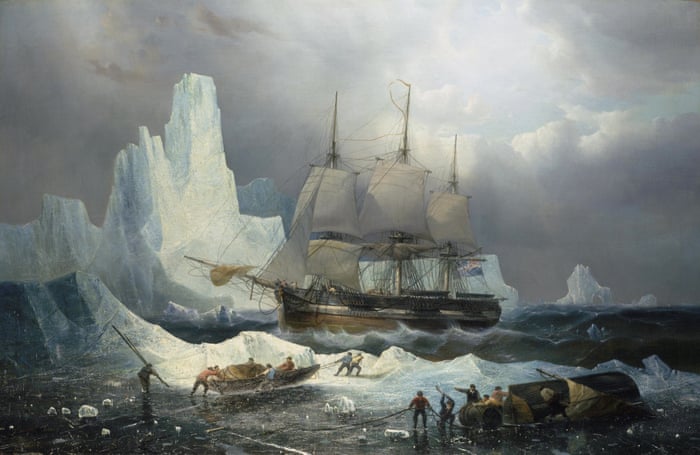The Franklin Terror and Erebus Northwest Passage Expedition
 |
| Francois Etienne Musin’s Erebus on Ice (1846) Photograph: National Maritime Museum |
"People are superstitious. They feel there is a connection between the deaths and disturbing the wreck sites."
"My late mother told me, even before these wrecks [HMS Terror and Erebus of the 1845 Arctic Franklin expedition] were discovered ... the whole King William Island has non-human people that we cannot see."
"It's a funny feeling when we get on the other side of the island. You sense that somebody's around you, but there's nobody around you."
"It was always like that, even before these shipwrecks were found."
"My mother used to warn me] Don't let them get to you – just do what you have to do."
Jacob Keanik, president, Nattilik Heritage Centre, Gjoa Haven, King William Island, Nunavut
 |
| Louie Kammokak (left) and Jacob Keanik (right) in 2015 at the blessing of the wreck of HMS Erebus. (Parks Canada) |
"It is only artifacts that are being taken off wreck sites."
"There are plans in place that if any bodies are found [in and around the wrecked ships' sites on the ocean bottom], they will be left in place."
"We will not bring up or disturb human remains."
Fred Pedersen, Kitikmeot Inuit Association
"This summer, following the tragedies, elders blessed sand from Gjoa Haven and the Terror Guardians brought it to the wreck of HMS Terror, where they sprinkled it over the wreck and performed a blessing."
"Both of these blessings were led by Inuit from Gjoa Haven."
Parks Canada spokesperson Dominique Tessier
 |
| The ship's wheel of HMS Terror. Some in the 1000-member Inuit community link recent deaths with its rediscovery. Parks Canada/Thierry Boyer/The Canadian Press |
The search for the fabled Northwest Passage from the Arctic to shorten long sea voyages and connect from the Atlantic to the Pacific consumed the British Royal Navy which sent ship after ship to investigate the presence of the passage -- during times when the Navy wasn't otherwise occupied in fighting various wars -- and to chart the Arctic, to no avail. Finally, a last stab at its location to discover a route through the vast sea-iced Arctic was undertaken by an elderly and unfit Sir John Franklin, his last stab at acquiring notable explorer-status.
 |
| Maps showing the route of the Franklin expedition and New York-Hong Kong’s flight trajectory. (Cryopolitics) |
His voyage too was destined to end in failure, but it is also known for the tragedy that ensued while he led the expedition when all hands were lost when sea-ice trapped his ships and ultimately the sea claimed them. He died himself of illness before the full tragedy struck, but there were no survivors from the expedition. Ship after ship was dispatched from Britain to search for the missing vessels and every one returned with no hints to solve the mystery of what had occurred to the expedition. It was considered a great disaster with the deaths of 129 crewmen.
Remains were eventually discovered. Along with some grisly evidence that in their desperation to survive cannibalism took place. Through their oral tradition, memory of local Inuit coming across some of the crew in a parlous state was handed down from generation to generation. That memory and its recounting immeasurably helped in the discovery of the wrecks by Canadian divers in 2014 finding Erebus and in 2016 when Terror's preserved underwater presence was discovered.
 |
| A 1945 photo of skulls, bleached white by the sun, discovered around King William Island in what is now Nunavut. |
Since the wrecks' discovery divers have been carrying off artifacts from the wrecks for historical preservation. Great Britain ceded ownership of the ships and all their artifacts to Canada. The artifacts when fully assembled will be placed on public display. What has disturbed local Inuit is their belief that disturbing the dead will bring their spirits back to life and they will wreak vengeance. Six deaths of natural causes and accidents that occurred in the space of two weeks the past summer led the Inuit community to the conclusion that the wrecks should have been left as they were, undisturbed.
Traditional local Inuit "guardians" performed a formal blessing soon after the Erebus wreck was discovered. Then the realization struck that no blessing had been carried out when the Terror was discovered. Belatedly that blessing was performed and the purpose of it was not only to carry on the traditions respecting history. heritage, and the site of deaths on the island, but in the hope of pacifying the demons the Inuit feel certain occupy the island, and in so doing, putting an end to the "curse" they are convinced has been provoked.
Following the community's tragedies of the six deaths -- two men dead from an all-terrain vehicle accident, another two the result of a boating accident, then the death of a local school staff member who died of a heart attack, and the final death, that of an elder dying of old age -- a traditional ceremony took place where community elders blessed sand taken from Gjoa Haven, to sprinkle it over the wreck of HMS Terror.
 |
| The small community of Gjoa Haven is on King William Island in Nunavut. The wreck of HMS Terror was found in an island bay, while HMS Erebus was found further south. (CBC News) |
Labels: Franklin Expedition, Great Britain, Inuit, Northwest Passage, Nunavut

0 Comments:
Post a Comment
<< Home